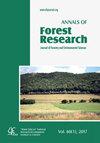Phytosociological approach to scree and ravine forest vegetation in Slovakia
IF 1.7
3区 农林科学
Q2 FORESTRY
引用次数: 10
Abstract
The aim of the study was to perform phytosociological revision of the scree and ravine forest vegetation in Slovakia in order to identify i) basic vegetation units of vegetation according to their floristic composition, and ii) to find out the main environmental gradients affecting their compositional variability. Releves originally assigned to broadly comprehended alliance Tilio platyphylli-Acerion (974 releves) were used for the analyses. In order to select final dataset (527 releves), formal criteria, such as tree layer cover >50%, releve area of 200–500 m 2 and presence at least two from six traditionally accepted diagnostic species of the alliance in Central Europe ( Acer platanoides , Lunaria rediviva , Phyllitis scolopendrium , Polystichum aculeatum , Tilia platyphyllos and Ulmus glabra ) were applied to the primal dataset. Altitude, aspect, slope, climatic characteristics (mean annual precipitation and air temperature), geological bedrock and Ellenberg indicator values (EIVs) were specified for each phytosociological releve. We used modified TWINSPAN algorithm for classification, Detrended Correspondence Analysis (DCA) for explanation of species composition-environmental relationships, and both ANOVA corrected using modified permutation test and Mann-Whitney U-test to test environmental differences at each step of division by numerical classification. Two alliances, Melico-Tilion platyphylli and Tilio platyphylli-Acerion were distinguished with three ( Aceri platanoidis-Tilietum platyphylli , Scolopendrio-Fraxinetum and Seslerio heufleranae-Quercetum petraeae ) and two ( Mercuriali perennis-Fraxinetum excelsioris and Lunario redivivae-Aceretum pseudoplatani ) associations, respectively. Besides the floristic composition, other important factors for differentiation of the associations were altitude and related climatic characteristics. The main environmental characteristics affecting the overall compositional variability of studied forests were EIVs for light, moisture, soil reaction and temperature. The complex syntaxonomical revision identified five floristically and ecologically clearly differentiated associations, what reduced the number to almost half of previously distinguished communities from the territory of Slovakia. Moreover, presented concept is at alliance level in accordance with recent European classification approach.斯洛伐克碎石和峡谷森林植被的植物社会学方法
本研究的目的是对斯洛伐克的片地和沟谷森林植被进行植物社会学修正,以便根据植被的区系组成确定植被的基本植被单位,并找出影响其组成变异的主要环境梯度。最初分配给广泛理解的联盟tilo platyphylli-Acerion的基因片段(974个基因片段)被用于分析。为了选择最终数据集(527层),将正式标准应用于原始数据集,如树木层覆盖率为50%,相关面积为200-500 m2,并且至少存在中欧联盟六种传统上公认的诊断物种中的两种(platanoides, Lunaria reviva, Phyllitis scolopendum, Polystichum acleatum, Tilia platyphyllos和Ulmus glabra)。海拔、坡向、坡度、气候特征(年平均降水量和气温)、地质基岩和Ellenberg指标值(eiv)被指定为每个植物社会学相关。我们使用改进的TWINSPAN算法进行分类,使用去趋势对应分析(DCA)解释物种组成-环境关系,并使用改进的排列检验和Mann-Whitney u -检验进行方差分析,以检验数值分类中每一步的环境差异。分别鉴定出3个(Aceri platanoidi - tilietum platyphylli, Scolopendrio-Fraxinetum和Seslerio heuflerana - quercetum peeeae)和2个(Mercuriali perennii - fraxinetum excelsioris和Lunario revivae - aceretum pseudoplatani)组合。除植物区系组成外,海拔和相关气候特征是影响群落分化的重要因素。影响研究森林整体组成变异的主要环境特征是光、水分、土壤反应和温度的eiv。复杂的分类学修订确定了五个在植物区系和生态上明显区分的群落,这使斯洛伐克境内以前区分的群落的数量减少到几乎一半。此外,根据最近的欧洲分类方法,提出的概念是在联盟层面上的。
本文章由计算机程序翻译,如有差异,请以英文原文为准。
求助全文
约1分钟内获得全文
求助全文
来源期刊

Annals of Forest Research
FORESTRY-
CiteScore
2.20
自引率
11.10%
发文量
11
审稿时长
12 weeks
期刊介绍:
Annals of Forest Research is a semestrial open access journal, which publishes research articles, research notes and critical review papers, exclusively in English, on topics dealing with forestry and environmental sciences. The journal promotes high scientific level articles, by following international editorial conventions and by applying a peer-review selection process.
 求助内容:
求助内容: 应助结果提醒方式:
应助结果提醒方式:


